Deep Learning-Assisted Diagnostic System: Implant Brand Detection Using Improved IB-YOLOv10 in Periapical Radiographs
Abstract
1. Introduction
2. Materials and Methods
2.1. PA Implant Brand Dataset Collection
2.2. Implant Brand Feature Extraction
2.2.1. Bilateral Filter
2.2.2. Gamma Correction
2.2.3. Contrast-Limited Adaptive Histogram Equalization
2.2.4. Edge Crispening
2.2.5. Negative Film
2.3. PA Resolution Enhancement
2.3.1. Dark Channel Prior
2.3.2. Lanczos Interpolation
2.4. Object Detection Training and Validation
2.4.1. YOLO Model
2.4.2. Experiment Setting
2.4.3. Validation Method
3. Experiment Results
3.1. Original Implant Brand Dataset Training and Evaluation
3.2. Enhancement Implant Brand Dataset Training and Evaluation
4. Discussion
- We are the first study to propose a deep learning-based approach for 3i and Xive implant brand detection in PA, aiming to assist new and experienced dentists in clinical diagnosis. Our proposed method achieves 94.5% accuracy in 3i and Xive implant brands across two common PA resolutions in real-world clinical scenarios.
- This study proposes IB-YOLOv10, an object detection model for implant brand classification based on YOLOv10. Compared to YOLOv8 and YOLOv10, IB-YOLOv10 improves detection accuracy by 4.3% and 2.6%.
- This study introduces a novel feature extraction method for implant brand classification by integrating multiple image processing techniques and a resolution enhancement technique based on Lanczos interpolation and Dark Channel Prior. The experimental results show that, compared to the original dataset, applying implant brand feature extraction and PA resolution enhancement in IB-YOLOv10 increases implant brand detection accuracy by 17.8%.
5. Conclusions
Author Contributions
Funding
Institutional Review Board Statement
Informed Consent Statement
Data Availability Statement
Acknowledgments
Conflicts of Interest
References
- A-Dan, W.; Jun-Qi, L. Factors associated with the oral health-related quality of life in elderly persons in dental clinic: Validation of a Mandarin Chinese version of GOHAI. Gerodontology 2011, 28, 184–191. [Google Scholar] [CrossRef] [PubMed]
- Dikicier, S.; Atay, A.; Korkmaz, C. Health-related quality of life in edentulous patients. J. Med. Life 2021, 14, 683–689. [Google Scholar] [CrossRef] [PubMed]
- AL-Omiri, M.K.; Karasneh, J.A.; Lynch, E.; Lamey, P.-J.; Clifford, T.J. Impacts of missing upper anterior teeth on daily living. Int. Dent. J. 2009, 59, 127–132. [Google Scholar] [CrossRef]
- Yurkstas, A.A. The effect of missing teeth on masticatory performance and efficiency. J. Prosthet. Dent. 1954, 4, 120–123. [Google Scholar] [CrossRef]
- Shigli, K.; Hebbal, M. Assessment of changes in oral health-related quality of life among patients with complete denture before and 1 month post-insertion using Geriatric Oral Health Assessment Index. Gerodontology 2010, 27, 167–173. [Google Scholar] [CrossRef]
- Husain, A.A.-H.; De Cicco, O.; Stadlinger, B.; Bosshard, F.A.; Schmidt, V.; Özcan, M.; Valdec, S. A Survey on Attitude, Awareness, and Knowledge of Patients Regarding the Use of Dental Implants at a Swiss University Clinic. Dent. J. 2023, 11, 165. [Google Scholar] [CrossRef]
- Esposito, M.; Grusovin, M.G.; Maghaireh, H.; Worthington, H.V. Interventions for replacing missing teeth: Different times for loading dental implants. Cochrane Database Syst. Rev. 2013, 3, CD003878. [Google Scholar] [CrossRef]
- Salim, H.A.; Naser, A.I.; Delemi, Z.H. Assessment of Peri Implant Osteal Changes by Radiographic Evaluation Using Standard Orthopantomograph and Periapical View a Retrospective Study. Al-Rafidain Dent. J. 2018, 18, 59–66. [Google Scholar] [CrossRef]
- Sahrmann, P.; Kühl, S.; Dagassan-Berndt, D.; Bornstein, M.M.; Zitzmann, N.U. Radiographic assessment of the peri-implant site. Periodontol. 2000 2024, 95, 70–86. [Google Scholar] [CrossRef]
- Clark, D.; Levin, L. In the dental implant era, why do we still bother saving teeth? Dent. Traumatol. 2019, 35, 368–375. [Google Scholar] [CrossRef]
- Stanford, C. Surface modifications of dental implants. Aust. Dent. J. 2008, 53, S26–S33. [Google Scholar] [CrossRef] [PubMed]
- Sailer, I.; Karasan, D.; Todorovic, A.; Ligoutsikou, M.; Pjetursson, B.E. Prosthetic failures in dental implant therapy. Periodontol. 2000 2022, 88, 130–144. [Google Scholar] [CrossRef] [PubMed]
- De Kok, I.J.; Duqum, I.S.; Katz, L.H.; Cooper, L.F. Management of Implant/Prosthodontic Complications. Dent. Clin. N. Am. 2019, 63, 217–231. [Google Scholar] [CrossRef] [PubMed]
- Ogle, O.E. Implant surface material, design, and osseointegration. Dent. Clin. N. Am. 2015, 59, 505–520. [Google Scholar] [CrossRef]
- Xuereb, M.; Camilleri, J.; Attard, N.J. Systematic review of current dental implant coating materials and novel coating techniques. Int. J. Prosthodont. 2015, 28, 51–59. [Google Scholar] [CrossRef]
- Mosavar, A.; Ziaei, A.; Kadkhodaei, M. The effect of implant thread design on stress distribution in anisotropic bone with different osseointegration conditions: A finite element analysis. Int. J. Oral Maxillofac. Implant. 2015, 30, 1317–1326. [Google Scholar] [CrossRef]
- Montemezzi, P.; Ferrini, F.; Pantaleo, G.; Gherlone, E.; Capparè, P. Dental Implants with Different Neck Design: A Prospective Clinical Comparative Study with 2-Year Follow-Up. Materials 2020, 13, 1029. [Google Scholar] [CrossRef]
- Grandi, T.; Garuti, G.; Samarani, R.; Guazzi, P.; Forabosco, A. Immediate Loading of Single Post-Extractive Implants in the Anterior Maxilla: 12-Month Results from a Multicenter Clinical Study. J. Oral Implantol. 2012, 38, 477–484. [Google Scholar] [CrossRef]
- Oshida, Y.; Tuna, E.B.; Aktören, O.; Gençay, K. Dental implant systems. Int. J. Mol. Sci. 2010, 11, 1580–1678. [Google Scholar] [CrossRef]
- Bäumer, A.; Toekan, S.; Saure, D.; Körner, G. Survival and success of implants in a private periodontal practice: A 10 year retrospective study. BMC Oral Health 2020, 20, 92. [Google Scholar] [CrossRef]
- Singh, T.; Ghimire, T.R.; Agrawal, S.K. Awareness of Biomedical Waste Management in Dental Students in Different Dental Colleges in Nepal. Biomed. Res. Int. 2018, 2018, 1742326. [Google Scholar] [CrossRef] [PubMed]
- Rizvi, N.; Alyahya, Y.; Rizvi, A.; Narvekar, U.; Petridis, H. Accuracy of Original vs. Non-Original Abutments Using Various Connection Geometries for Single Unit Restorations: A Systematic Review. J. Prosthodont. 2022, 31, e21–e52. [Google Scholar] [CrossRef] [PubMed]
- Lin, T.-J.; Mao, Y.-C.; Lin, Y.-J.; Liang, C.-H.; He, Y.-Q.; Hsu, Y.-C.; Chen, S.-L.; Chen, T.-Y.; Chen, C.-A.; Li, K.-C.; et al. Evaluation of the Alveolar Crest and Cemento-Enamel Junction in Periodontitis Using Object Detection on Periapical Radiographs. Diagnostics 2024, 14, 1687. [Google Scholar] [CrossRef]
- Lin, T.-J.; Lin, Y.-T.; Lin, Y.-J.; Tseng, A.-Y.; Lin, C.-Y.; Lo, L.-T.; Chen, T.-Y.; Chen, S.-L.; Chen, C.-A.; Li, K.-C.; et al. Auxiliary Diagnosis of Dental Calculus Based on Deep Learning and Image Enhancement by Bitewing Radiographs. Bioengineering 2024, 11, 675. [Google Scholar] [CrossRef]
- Ibraheem, W.I. Accuracy of Artificial Intelligence Models in Dental Implant Fixture Identification and Classification from Radiographs: A Systematic Review. Diagnostics 2024, 14, 806. [Google Scholar] [CrossRef]
- Mao, Y.-C.; Huang, Y.-C.; Chen, T.-Y.; Li, K.-C.; Lin, Y.-J.; Liu, Y.-L.; Yan, H.-R.; Yang, Y.-J.; Chen, C.-A.; Chen, S.-L.; et al. Deep Learning for Dental Diagnosis: A Novel Approach to Furcation Involvement Detection on Periapical Radiographs. Bioengineering 2023, 10, 802. [Google Scholar] [CrossRef]
- Wu, P.-Y.; Mao, Y.-C.; Lin, Y.-J.; Li, X.-H.; Ku, L.-T.; Li, K.-C.; Chen, C.-A.; Chen, T.-Y.; Chen, S.-L.; Tu, W.-C.; et al. Precision Medicine for Apical Lesions and Peri-Endo Combined Lesions Based on Transfer Learning Using Periapical Radiographs. Bioengineering 2024, 11, 877. [Google Scholar] [CrossRef]
- Zhang, C.; Fan, L.; Zhang, S.; Zhao, J.; Gu, Y. Deep learning based dental implant failure prediction from periapical and panoramic films. Quant. Imaging Med. Surg. 2023, 13, 935–945. [Google Scholar] [CrossRef]
- Chen, Y.-C.; Chen, M.-Y.; Chen, T.-Y.; Chan, M.-L.; Huang, Y.-Y.; Liu, Y.-L.; Lee, P.-T.; Lin, G.-J.; Li, T.-F.; Chen, C.-A.; et al. Improving Dental Implant Outcomes: CNN-Based System Accurately Measures Degree of Peri-Implantitis Damage on Periapical Film. Bioengineering 2023, 10, 640. [Google Scholar] [CrossRef]
- Vera, M.; Gómez-Silva, M.J.; Vera, V.; López-González, C.I.; Aliaga, I.; Gascó, E.; Vera-González, V.; Pedrera-Canal, M.; Besada-Portas, E.; Pajares, G. Artificial Intelligence Techniques for Automatic Detection of Peri-implant Marginal Bone Remodeling in Intraoral Radiographs. J. Digit. Imaging 2023, 36, 2259–2277. [Google Scholar] [CrossRef]
- Baker, O.; Ziran, Z.; Mecella, M.; Subaramaniam, K.; Palaniappan, S. Predictive Modeling for Pandemic Forecasting: A COVID-19 Study in New Zealand and Partner Countries. Int. J. Environ. Res. Public Health 2025, 22, 562. [Google Scholar] [CrossRef] [PubMed]
- Kwiatkowska-Miernik, A.; Wasilewski, P.G.; Mruk, B.; Sklinda, K.; Bujko, M.; Walecki, J. Estimating Progression-Free Survival in Patients with Primary High-Grade Glioma Using Machine Learning. J. Clin. Med. 2024, 13, 6172. [Google Scholar] [CrossRef] [PubMed]
- Tomasi, C.; Manduchi, R. Bilateral Filtering for Gray and Color Images. In Proceedings of the 1998 IEEE International Conference on Computer Vision (ICCV), Bombay, India, 4–7 January 1998; pp. 839–846. [Google Scholar] [CrossRef]
- Soni, S.; Singh, P.; Waoo, A.A. Review of Gamma Correction Techniques in Digital Imaging. ShodhKosh J. Vis. Perform. Arts 2024, 5, 473–479. [Google Scholar] [CrossRef]
- Ari, T.; Sağlam, H.; Öksüzoğlu, H.; Kazan, O.; Bayrakdar, I.Ş.; Duman, S.B.; Çelik, Ö.; Jagtap, R.; Futyma-Gąbka, K.; Różyło-Kalinowska, I.; et al. Automatic Feature Segmentation in Dental Periapical Radiographs. Diagnostics 2022, 12, 3081. [Google Scholar] [CrossRef]
- He, K.; Sun, J.; Tang, X. Single Image Haze Removal Using Dark Channel Prior. In Proceedings of the IEEE Conference on Computer Vision and Pattern Recognition (CVPR), Miami, FL, USA, 20–25 June 2009; pp. 1956–1963. [Google Scholar] [CrossRef]
- Lee, D.Y.; Kim, J.Y.; Cho, S.Y. Improving Medical Image Quality Using a Super-Resolution Technique with Attention Mechanism. Appl. Sci. 2025, 15, 867. [Google Scholar] [CrossRef]
- Duchon, C.E. Lanczos Filtering in One and Two Dimensions. J. Appl. Meteorol. (1962–1982) 1979, 18, 1016–1022. [Google Scholar] [CrossRef]
- Lee, J.-H.; Kim, Y.-T.; Lee, J.-B.; Jeong, S.-N. Deep learning improves implant classification by dental professionals: A multi-center evaluation of accuracy and efficiency. J. Periodontal Implant. Sci. 2021, 52, 220–229. [Google Scholar] [CrossRef]
- Park, W.; Schwendicke, F.; Krois, J.; Huh, J.-K.; Lee, J.-H. Identification of Dental Implant Systems Using a Large-Scale Multicenter Data Set. J. Dent. Res. 2023, 102, 727–733. [Google Scholar] [CrossRef]
- Lee, D.-W.; Kim, S.-Y.; Jeong, S.-N.; Lee, J.-H. Artificial Intelligence in Fractured Dental Implant Detection and Classification: Evaluation Using Dataset from Two Dental Hospitals. Diagnostics 2021, 11, 233. [Google Scholar] [CrossRef]






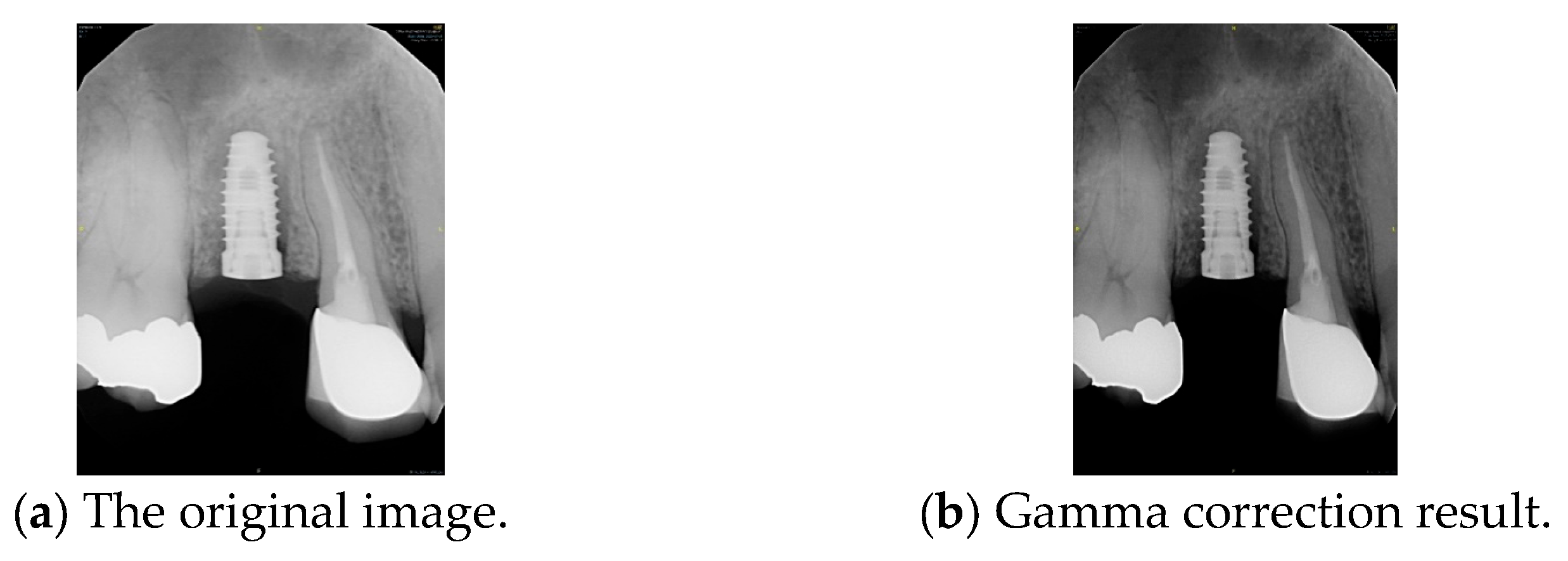
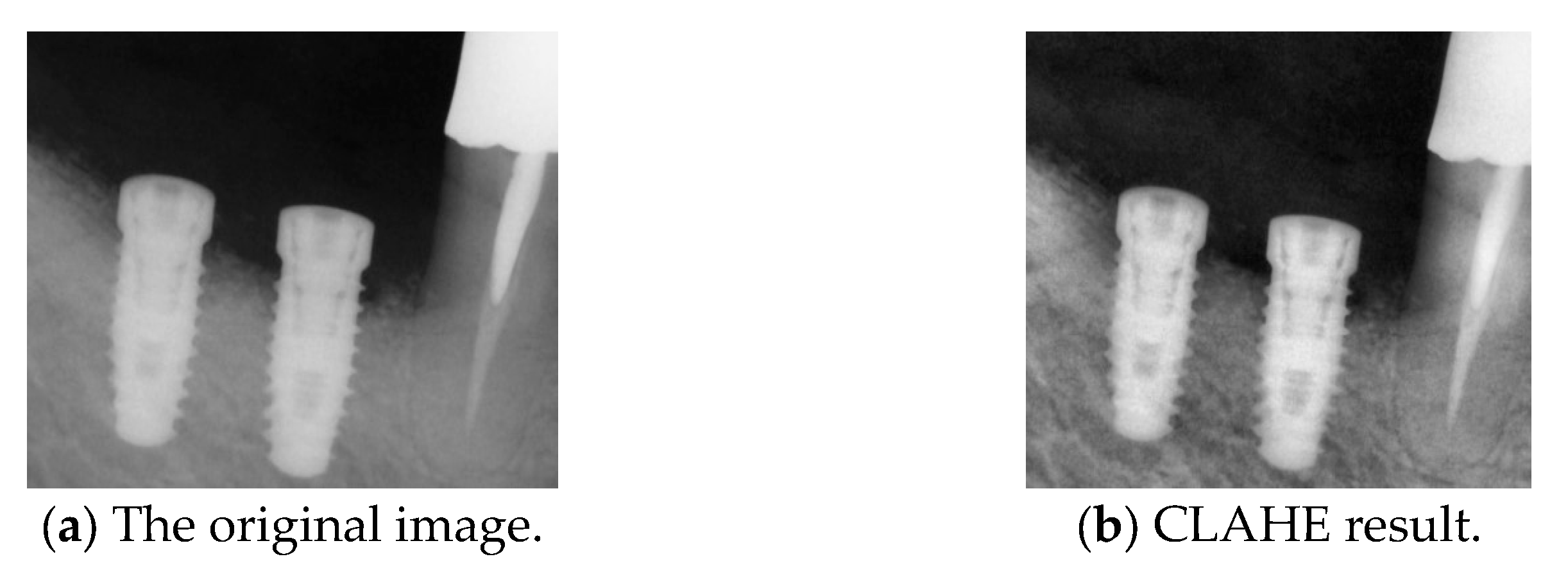

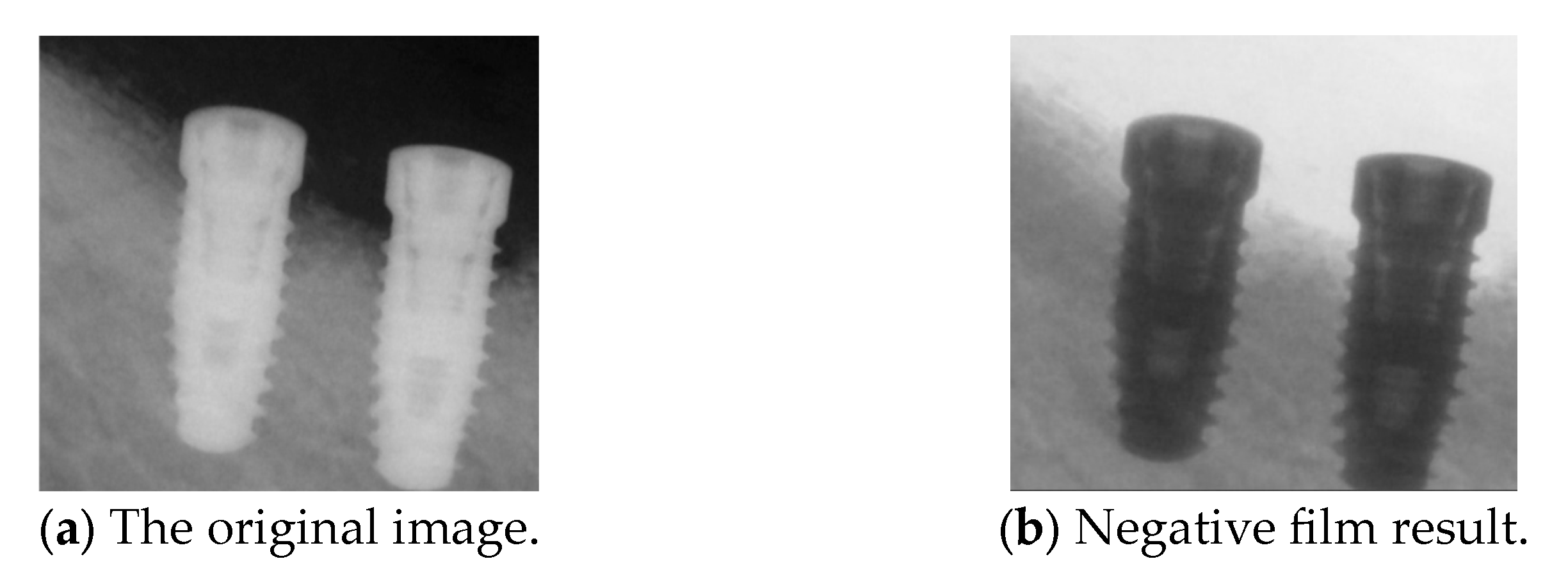
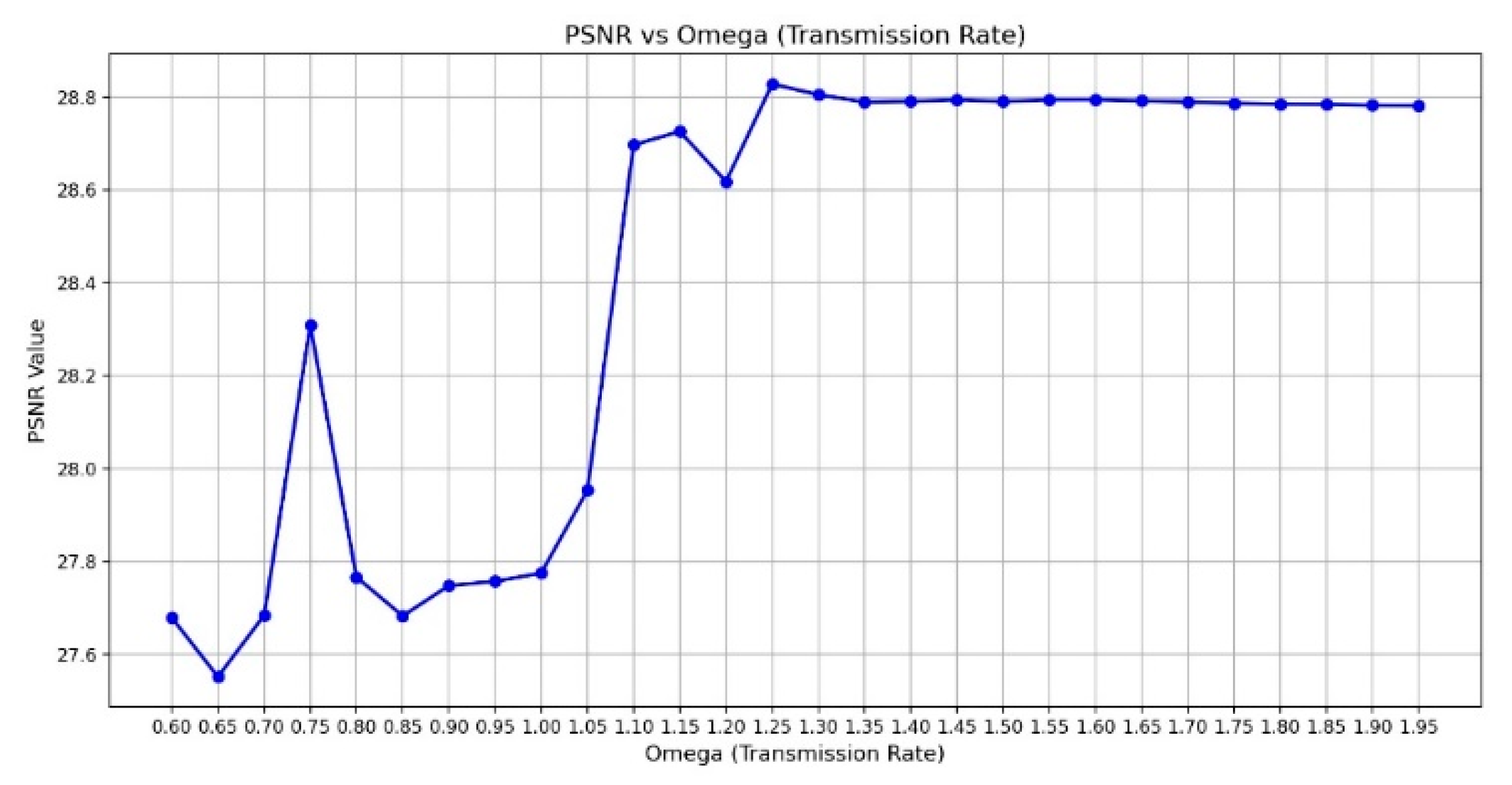

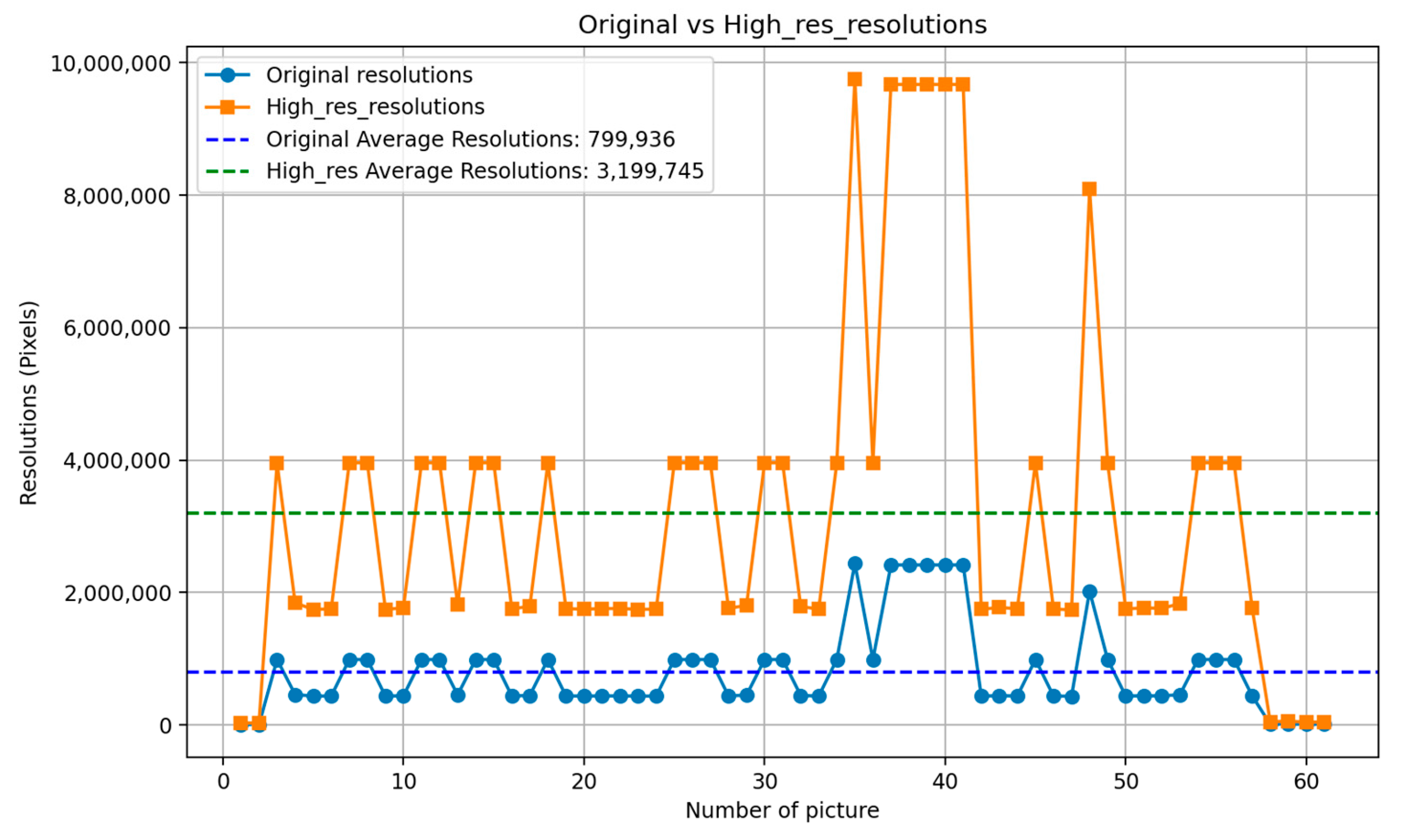

| Implant Brand | 3i | Xive |
|---|---|---|
| Dimension (D) | 3.25 mm/4 mm/5 mm/6 mm | 3.4 mm/3.8 mm/4.5 mm/5.5 mm |
| Length (L) | 8.5 mm/10 mm/11.5 mm/13 mm/15 mm | 8 mm/9.5 mm/11 mm/13 mm/15 mm/18 mm |
| PA Imaging Methodology | |||
|---|---|---|---|
| Exposure Time | Incrementally adjustable from 0.03 to 3.2 s | Image developing speed | 5 s |
| X-Ray Generator | High frequency generator for constant high | Sensor size (mm) | 31.3 × 44.5 |
| Image Size | 825 × 1200 or 820 × 562 | Image format | DCI |
| The dataset includes two implant brands: 3i and Xive | |||
| 3i | 164 | Xive | 77 |
| Training Set | Validation Set | Test Set | Total |
| 178 | 43 | 20 | 241 |
| Hardware Platform | Version |
|---|---|
| CPU | AMD Ryzen™ R7-7700@3.80 GHz |
| GPU | NVIDIA GeForce RTX 3070 8G |
| DRAM | 64 GB |
| Software platform | version |
| Python | 3.9.31 |
| PyTorch | 2.4 + cu121 |
| CUDA | 12.1 |
| Layer | Layer Type | Kernel Size | Stride | Filters Number | Future Map Size |
|---|---|---|---|---|---|
| 1 | Convolution | 5 × 5 | 2 | 64 | 256 × 256 × 16 |
| 2 | Convolution | 3 × 3 | 2 | 128 | 128 × 128 × 32 |
| 3 | C2f | - | - | 256 | 128 × 128 × 64 |
| 4 | Convolution | 3 × 3 | 2 | 256 | 64 × 64 × 64 |
| 5 | C2f | - | - | 512 | 64 × 64 × 128 |
| 6 | Convolution | 3 × 3 | 2 | 512 | 32 × 32 × 128 |
| 7 | C2f | - | - | 512 | 32 × 32 × 128 |
| 8 | Convolution | 3 × 3 | 2 | 1024 | 16 × 16 × 256 |
| 9 | C2f | - | - | 1024 | 16 × 16 × 256 |
| 10 | SPPF | 5 × 5 | - | 1024 | 16 × 16 × 256 |
| 11 | C2PSA | - | - | 1024 | 16 × 16 × 256 |
| 12 | Upsample | - | - | 1024 | 32 × 32 × 256 |
| 13 | Concatenation | - | - | 1024 | 32 × 32 × 256 |
| 14 | C2f | - | - | 512 | 32 × 32 × 128 |
| 15 | Upsample | - | - | 512 | 64 × 64 × 128 |
| 16 | Concatenation | - | - | 512 | 64 × 64 × 128 |
| 17 | C2f | - | - | 256 | 64 × 64 × 64 |
| 18 | Convolution | 3 × 3 | 2 | 256 | 32 × 32 × 128 |
| 19 | Concatenation | - | - | 256 | 32 × 32 × 128 |
| 20 | C2f | - | - | 512 | 32 × 32 × 128 |
| 21 | Convolution | 3 × 3 | 2 | 512 | 16 × 16 × 128 |
| 22 | Concatenation | 512 | 16 × 16 × 128 | ||
| 23 | C2f | 20 × 20 × 256 | 16 × 16 × 128 |
| Hyperparameter | Value | Hyperparameter | Value |
|---|---|---|---|
| Initial Learning Rate | 0.0005 | Hue | 0.015 |
| Final Learning Rate | 0.1 | Saturation | 0.7 |
| Image Size | 256 | Brightness | 0.4 |
| Epochs | 500 | Translation | 0.1 |
| Batch | 16 | Scale | 0.5 |
| Stopping Patience | 50 | Horizontal flip | 0.5 |
| L2 Regularization | 0.0007 | Mosaic augmentation | 0.8 |
| Momentum | 0.937 | Mixup augmentation | 0.2 |
| Accuracy | Recall (Average) | Recall (Max) | Precision (Average) | Precision (Max) | mAP50 (Average) | mAP50 (Max) | |
|---|---|---|---|---|---|---|---|
| YOLOv8 | 50.6% | 56.3% | 58.4% | 58.2% | 59.9% | 58.9% | 58.4% |
| YOLOv10 | 53.8% | 55.9% | 57.6% | 54.8% | 57.7% | 59.1% | 57.7% |
| IB-YOLOv10 | 56.8% | 52.2% | 56.2% | 54% | 57.3% | 55.2% | 56.8% |
| VMF | R15 | GB | IM | Accuracy (8, 10, IB-v10) | mAP50 (8, 10, IB-v10) | Precision (8, 10, IB-v10) | Recall (8, 10, IB-v10) |
|---|---|---|---|---|---|---|---|
| 1 | 50.6/53.8/56.8 | 58.4/57.7/56.8 | 59.9/57.7/57.3 | 58.4/57.6/56.2 | |||
| ✓ | 2 | 57.6/66.1/67.8 | 52.9/53.2/60.5 | 53.1/61.9/67.0 | 55.4/59.9/65.9 | ||
| ✓ | 2 | 60.4/66.2/66.6 | 57.5/55.5/59.8 | 64.7/61.6/65.1 | 64.1/63.2/57.8 | ||
| ✓ | 2 | 65.0/64.2/64.8 | 57.3/60.2/61.8 | 55.3/61.5/57.7 | 53.8/60.2/58.4 | ||
| ✓ | ✓ | 3 | 71.4/73.4/72.1 | 68.3/71.6/72.9 | 68.8/74.5/72.4 | 74.9/75.2/71.8 | |
| ✓ | ✓ | 3 | 71.5/74.7/73.3 | 68.2/72.3/71.5 | 71.2/70.4/73.3 | 75.6/73.7/78.3 | |
| ✓ | ✓ | 3 | 71.6/69.6/72.4 | 68.6/69.3/74.1 | 70.7/71.3/74.2 | 71.2/74.2/76.3 | |
| ✓ | ✓ | ✓ | 4 | 74.9/75.7/77.7 | 73.4/74.5/76.3 | 76.9/74.1/77.5 | 71.2/73.4/78.7 |
| BF | EC | GC | CLAHE | NFE | PARE | Accuracy (8, 10, IB-v10) | mAP50 (8, 10, IB-v10) | Precision (8, 10, IB-v10) | Recall (8, 10, IB-v10) |
|---|---|---|---|---|---|---|---|---|---|
| 74.9/75.7/77.7 | 73.4/74.5/76.3 | 76.9/74.1/77.5 | 71.2/73.4/78.7 | ||||||
| ✓ | ✓ | ✓ | 77.3/78.1/81.2 | 78.6/83.0/82.5 | 78.7/82.4/81.1 | 79.3/80.5/81.6 | |||
| ✓ | ✓ | ✓ | 81.8/79.5/82.6 | 76.6/83.4/83.7 | 82.3/84.5/83.8 | 81.2/82.3/83.4 | |||
| ✓ | ✓ | ✓ | ✓ | 84.6/87.2/89.9 | 80.2/88.6/90.2 | 88.2/91.6/92.1 | 88.9/91.7/91.6 | ||
| ✓ | ✓ | ✓ | ✓ | ✓ | 86.7/91.5/93.4 | 84.7/90.3/91.0 | 88.2/91.5/93.9 | 88.6/91.8/92.1 | |
| ✓ | ✓ | ✓ | ✓ | ✓ | ✓ | 90.8/93.3/95.5 | 93.5/93.7/96.7 | 91.9/93.5/96.8 | 92.0/93.2/95.3 |
| Accuracy (Average) | Recall (Average) | Recall (Max) | Precision (Average) | Precision (Max) | mAP50 (Average) | mAP50 (Max) | |
|---|---|---|---|---|---|---|---|
| YOLOv8 | 90.2% | 92% | 96.9% | 91.9% | 98.3% | 92.9% | 94.2% |
| YOLOv10 | 91.9% | 93.2% | 98.4% | 93.5% | 98.1% | 93.2% | 96.7% |
| IB-YOLOv10 | 94.5% | 93.3% | 99.9% | 96.8% | 99.2% | 96.4% | 98.2% |
| Actual | |||
|---|---|---|---|
| 3i | Xive | ||
| Predicted | 3i | 95 | 1 |
| Xive | 2 | 70 | |
| Image Resolution = 825 × 1200 | ||||
|---|---|---|---|---|
| Test Image 1–4 |  |  |  |  |
| Accuracy | 94.13% | 95.29% | 92.88% | 91.80% |
| Recall | 96.71% | 94.03% | 93.88% | 92.15% |
| Model reference time | 6.57 ms | 7.08 ms | 7.12 ms | 6.43 ms |
| Dentists’ average diagnostic time | 2.78 s | 4.55 s | 7.78 s | 7.23 s |
| Test Image 5–8 |  |  |  |  |
| Accuracy | 92.44% | 93.38% | 96.61% | 95.89% |
| Recall | 94.60% | 96.85% | 95.22% | 95.49% |
| Model reference time | 6.99 ms | 7.34 ms | 6.11 ms | 6.76 ms |
| Dentists’ average diagnostic time | 5.79 s | 3.87 s | 4.11 s | 2.45 s |
| Image resolution = 820 × 552 | ||||
| Test Image 9–12 |  |  |  |  |
| Accuracy | 94.11% | 95.06% | 94.82% | 90.97%/92.86% |
| Recall | 96.19% | 95.72% | 95.99% | 94.12%/92.75% |
| Model reference time | 6.18 ms | 6.12 ms | 6.48 ms | 5.57 ms |
| Dentists’ average diagnostic time | 2.51 s | 5.65 s | 4.51 s | 3.44 s |
| Test Image 13–16 |  |  |  |  |
| Accuracy | 92.03% | 95.74% | 96.79% | 95.17% |
| Recall | 93.59% | 94.97% | 94.13% | 95.72% |
| Model reference time | 6.45 ms | 6.07 ms | 6.01 ms | 6.22 ms |
| Dentists’ average diagnostic time | 3.47 s | 6.89 s | 3.45 s | 4.77 s |
Disclaimer/Publisher’s Note: The statements, opinions and data contained in all publications are solely those of the individual author(s) and contributor(s) and not of MDPI and/or the editor(s). MDPI and/or the editor(s) disclaim responsibility for any injury to people or property resulting from any ideas, methods, instructions or products referred to in the content. |
© 2025 by the authors. Licensee MDPI, Basel, Switzerland. This article is an open access article distributed under the terms and conditions of the Creative Commons Attribution (CC BY) license (https://creativecommons.org/licenses/by/4.0/).
Share and Cite
Lin, Y.-J.; Chen, S.-L.; Lu, Y.-C.; Lin, X.-M.; Mao, Y.-C.; Chen, M.-Y.; Yang, C.-S.; Chen, T.-Y.; Li, K.-C.; Tu, W.-C.; et al. Deep Learning-Assisted Diagnostic System: Implant Brand Detection Using Improved IB-YOLOv10 in Periapical Radiographs. Diagnostics 2025, 15, 1194. https://doi.org/10.3390/diagnostics15101194
Lin Y-J, Chen S-L, Lu Y-C, Lin X-M, Mao Y-C, Chen M-Y, Yang C-S, Chen T-Y, Li K-C, Tu W-C, et al. Deep Learning-Assisted Diagnostic System: Implant Brand Detection Using Improved IB-YOLOv10 in Periapical Radiographs. Diagnostics. 2025; 15(10):1194. https://doi.org/10.3390/diagnostics15101194
Chicago/Turabian StyleLin, Yuan-Jin, Shih-Lun Chen, Ya-Cheng Lu, Xu-Ming Lin, Yi-Cheng Mao, Ming-Yi Chen, Chao-Shun Yang, Tsung-Yi Chen, Kuo-Chen Li, Wei-Chen Tu, and et al. 2025. "Deep Learning-Assisted Diagnostic System: Implant Brand Detection Using Improved IB-YOLOv10 in Periapical Radiographs" Diagnostics 15, no. 10: 1194. https://doi.org/10.3390/diagnostics15101194
APA StyleLin, Y.-J., Chen, S.-L., Lu, Y.-C., Lin, X.-M., Mao, Y.-C., Chen, M.-Y., Yang, C.-S., Chen, T.-Y., Li, K.-C., Tu, W.-C., Abu, P. A. R., & Chen, C.-A. (2025). Deep Learning-Assisted Diagnostic System: Implant Brand Detection Using Improved IB-YOLOv10 in Periapical Radiographs. Diagnostics, 15(10), 1194. https://doi.org/10.3390/diagnostics15101194







